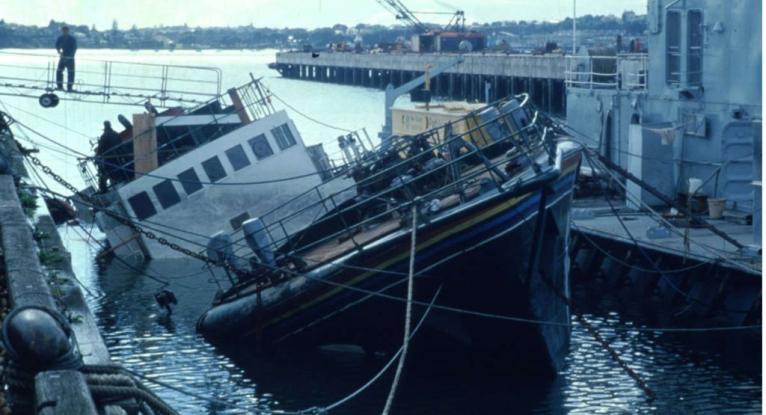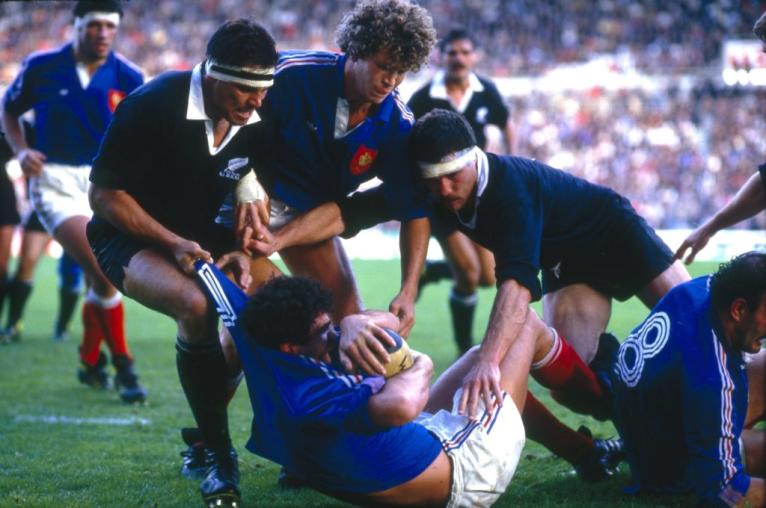There’s a reason why the rugby rivalry between France and New Zealand is so enthralling and that reason recently sailed up the River Clyde into Glasgow.
The Greenpeace yacht Rainbow Warrior carried four young global environmental activists to the COP26 climate conference, none of whom had been born when the vessel’s predecessor was at the centre of a notorious international incident in Auckland Harbour. It strained relations between France and New Zealand to breaking point, creating a tension and a hostility that found its outlet in the only sphere where the two countries were evenly matched: the rugby field.
Early in 1985, France’s Socialist government, under President François Mitterrand, announced that they were recommencing nuclear tests on the Pacific atoll of Moruroa, something they had first done in the early 1960s.
As a result of the nuclear testing of France and other nations, an environmental pressure group called Greenpeace was founded in 1971 and by 1985 they had their own vessel, the Rainbow Warrior, a 40-metre former British trawler.
In response to the French declaration, Greenpeace dispatched its ship to the Pacific to protest against the nuclear testing. But it never arrived. On the night of July 10, 1985, two French secret service agents clamped two mines to the hull of the Rainbow Warrior and sent it to the bottom of Auckland harbour, along with Fernando Pereira, a Greenpeace photographer. The vessel was refloated but scuttled two years later and there have since been two more Rainbow Warriors, the third of which sailed up the Clyde in October.

For two months the French government denied they had anything to do with the atrocity, but the arrest in New Zealand of the two agents forced them to come clean. In September 1985, French Prime Minister Laurent Fabius admitted: “French secret agents sunk this boat. They acted on orders.”
But France stopped short of apologising, nor did they condemn their agents because, in the words of Fabius, it would “be unacceptable to expose soldiers who merely obeyed orders and who have carried out very dangerous missions for our country in the past”.
New Zealand were enraged with the tepid French response. Prime Minister David Lange accused France of committing “a sordid act of state-backed international terrorism”, and he promised that the two agents, if convicted, would feel the full force of the law.
In November 1985, the pair – Major Alain Mafart and Captain Dominique Prieur – were jailed for 10 years. “People who come to this country and commit terrorist activities cannot expect to have a short holiday at the expense of our government and return home as heroes,” remarked the judge.
The ‘Battle of Nantes’ was reputed to be one of the most violent Test matches ever. New Zealand No8 Wayne Shelford bore the brunt of the French fury, requiring 20 stitches to repair his torn scrotum.
In June 1986, New Zealand and France met on the rugby field for the first time since the sinking of the Rainbow Warrior. The media attempted to turn it into a grudge match, but it was a challenge for New Zealand to seize the moral high ground given that a rebel All Blacks side had just toured South Africa. Those players were ineligible for the French Test and their callow replacements, dubbed the ‘Baby Blacks’, had other things on their mind than avenging the Rainbow Warrior. Only 24,000 fans turned up to Lancaster Park in Christchurch to see New Zealand pull off a surprise 18-9 win against the reigning Five Nations champions.
Five months later, a full-strength New Zealand side beat France in Toulouse. The second Test of the series was a week later in Brittany, what came to be known as the ‘Battle of Nantes’. It was a brutal encounter, reputed to be one of the most violent Test matches ever. New Zealand No8 Wayne Shelford bore the brunt of the French fury, requiring 20 stitches to repair his torn scrotum. “It bloody well hurt,” he remembered, although he returned to fray, only to be knocked out by a flying French prop.
It has subsequently been alleged that some of the French side were high on amphetamines that day; perhaps, or maybe their ferocity was fuelled by national pride, and when they tore into the All Blacks they were striking a blow for their two imprisoned secret agents. “It’s an unbelievable revenge we achieved,” said France coach Jacques Fouroux afterwards. He was talking in a sporting context, or was he?

The sinking of the Rainbow Warrior continued to simmer under the surface, creating distrust and discord between France and New Zealand. The two agents had been deported from New Zealand to the island of Hao in French Polynesia in July 1986 to serve out their prison sentences in accordance with a UN-sponsored agreement; in return France issued a formal apology and paid millions in compensation to both Greenpeace and the New Zealand government.
Neither agent stayed long in their tropical prison. Within two years the pair had been repatriated on medical grounds. The New Zealand government was furious, accusing France of “reneging on the agreement”.
At least New Zealand had the consolation of their 1987 inaugural World Cup triumph, made all the sweeter by the fact they had beaten France 29-9 in the final. That victory was the first of five consecutive wins for the All Blacks against France in a period when New Zealand crushed most of their opponents. In 1990, the rivalry fell into abeyance for four years as South Africa returned to the international fold and touring schedules were rearranged to accommodate the Springboks.
France toured New Zealand in 1994 and won both Tests, their first series victory against New Zealand. The second Test was a classic, the tourists winning 23-20 thanks to a wondrous last-minute try that captain Philippe Saint-André described as a “counter-attack from the end of the world – a true image of French rugby”.
The Rainbow Warrior incident was receding into distant memory by the time of the 1995 World Cup but, on the eve of the semi-finals, it was revived by an announcement from Paris. Three years after France had agreed to a moratorium on nuclear testing in the Pacific, the newly-elected President, Jacques Chirac, said that a series of eight tests would be conducted in the coming months. Global condemnation of France’s decision was almost unanimous. A spokesman for Bill Clinton, President of the USA, said they were “deeply disappointed” by the announcement and Japan made an official protest to France. New Zealanders were apoplectic. Prime Minister Jim Bolger said the two nations had been “friends for generations and in one act today France decided to hell with the friendship”.
One Kiwi MP, Winston Peters, expressed a hope that France and New Zealand would win their respective World Cup semi-finals and meet in the final so “we thump them”. His dream was thwarted by the Springboks, who beat France in the semi and New Zealand in the final.
The opposition Labour party called on the NZRU to cancel their tour of France that November in protest. “If the All Blacks tour France, you are appearing to give tacit approval to nuclear testing in our backyard,” warned Trevor Mallard, Labour’s spokesman for sport. “The issue will divide New Zealand and put a cloud over what has been a very successful year,” he added.

Some players made their own protest. All Black flanker Josh Kronfeld, one of the stars of the 1995 World Cup, daubed the words ‘Stop Testing’ on his scrum cap alongside a peace symbol when he played for Otago. “I don’t agree with what is going on there, especially after they left off a bomb, and I wanted to make a statement,” said Kronfeld.
The NZRU were not impressed. Not only had they no intention of cancelling the tour to France but they also wanted it to go as smoothly as possible. Kronfeld was informed by NZRU chairman Richie Guy that his headgear would not be tolerated on tour.
There has been a great relationship between the two countries for a long, long time. And apart from the Rainbow Warrior, we’ve probably been on the same page most of the time.
Steve Hansen
The two-Test series in November 1995 was drawn and, perhaps wisely, the two countries didn’t meet again until June 1999, when France were hammered 54-7 in Wellington. The French had their revenge the following November when they produced arguably the greatest comeback in World Cup history, overturning a 24-10 deficit in the second half to beat New Zealand 43-31 in an unforgettable semi-final.
The 21st Century has belonged to the All Blacks, victorious in all but three of their 27 encounters, although one of their rare defeats was the 2007 World Cup quarter-final. The last time France beat New Zealand was in 2009, and since then there have been some ugly humiliations: 52-11 in 2018, 30-0 in 2013 and a 62-13 thrashing in the 2015 World Cup. “There has been a great relationship between the two countries for a long, long time,” reflected Steve Hansen on the eve of that 2015 clash. “And apart from the Rainbow Warrior, we’ve probably been on the same page most of the time.”
None of the All Blacks who will run out in Paris next week were born when the French sent the ship to the bottom of Auckland Harbour. But the Rainbow Warrior still resonates in New Zealand and for a nation that lacks military might, the rugby field is where they can have their revenge. As George Orwell once wrote: “Serious sport has nothing to do with fair play. It is bound up with hatred, jealousy, boastfulness, disregard of all rules… in other words it is war minus the shooting.”


Comments
Join free and tell us what you really think!
Sign up for free